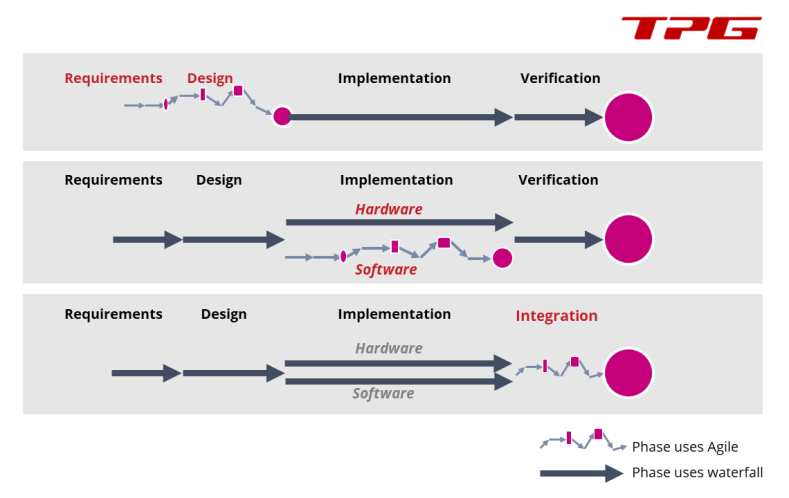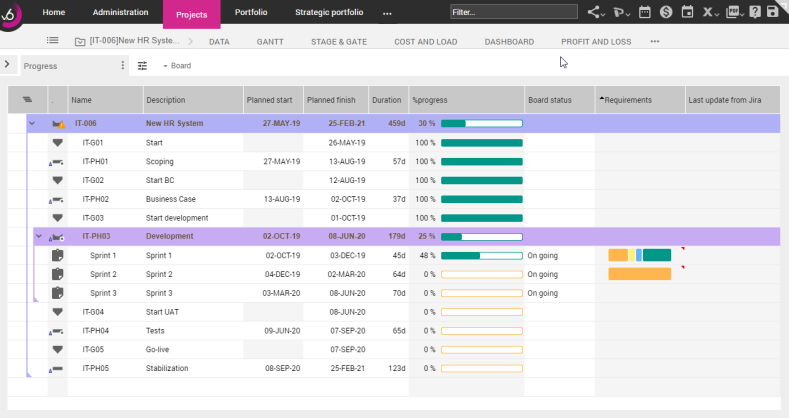One of these essential requirements of a PPM tool is the ability to manage both Agile and waterfall projects (and any combination thereof) from a single tool. Here's why.
"Agile vs. Waterfall: the revenge of the Hybrid Project”... Sounds like the title of a summer blockbuster. But it also neatly summarizes a (the?) key debate at the center of project management over the past decade or so.
Why use waterfall and Agile together?
Different types of projects suit different project methodologies. Projects with well defined requirements that are not subject to change, or that require highly reliable software will work well with waterfall, while exploratory projects with uncertain requirements and where the scope and timeline are difficult to determine in advance will benefit more from Agile methodologies.
A single organization may have dozens of projects running at the same time with some using waterfall, and others using Agile. For example, a company’s core business may center around a highly stable product platform with only incremental changes (for which waterfall is a good fit). But the same company may wish to experiment in an adjacent product space where it doesn’t have as much experience, or where the product is new to the world. For that project, Agile would be more recommended.
Projects don’t have to be all Agile or all waterfall. In fact, there are quite a few situations where a combination of both delivers many more benefits than either taken individually. For example, a company may choose to use waterfall to plan the large phases of a project, and use Agile to develop the product iteratively within each stage. By doing so, it maintains the structure of waterfall while increasing its ability to respond to real-time changes. This style of hybrid project management is often referred to as “Agile Stage-Gate”. The overall process looks something like this:

Diagram courtesy of TPG
Another way to combine Agile and waterfall is to do some bits of the project using one methodology, and some others using the other. For example:

Diagram courtesy of TPG
Hybrid methodologies combine the best of both worlds: the overall structure of waterfall, with the flexibility and human-centeredness of Agile. Giving your teams the option & flexibility to choose the methodology that best suits the characteristics of the project can be a significant way to boost the performance of your projects.
Even if you do not use Agile today, it is worth planning for the future: you need to know that if you change your processes, your PPM tool can and will change with you. Having the option to introduce Agile techniques in your existing waterfall processes in a controlled way is a great option to cultivate.
A good PPM tool will help you manage Agile, waterfall AND hybrid projects in the same tool
Agile, waterfall and hybrid project management approaches may follow different principles, but they still use the same resources (which you need to provide) and are accountable to the portfolio. Which is why a good Project and Portfolio Management solution will provide you with the data and the tools you need to monitor all your projects in a consolidated way regardless of methodology.
Not all data is worth consolidating at the portfolio level, but a good PPM tool will allow you to calculate and aggregate:
- Costs (labor, materials etc.)
- Project progress (see screenshot below), and
- Capacity (for example: what profile of people do I need to complete the tasks scheduled over the whole portfolio at any given time?)

For example, in this Planisware Enterprise screen, the portfolio manager can view progress of the projects in the portfolio regardless of whether the project is managed using waterfall (project IT-006) or Agile (project IT-PH03).
A good PPM tool will also include easy and comprehensive integration with third party applications (such as Jira), which will allow you for example to retrieve details of the work performed when it is managed outside of the PPM solution. It should also make it easy to connect projects back to the strategy, and assess alignment of the portfolio with the overarching business strategy.
Interested in seeing what Agile and waterfall projects working together in a portfolio looks like in real life? This short video presents a (simple) example of that:
Watch our NPD Hybrid Agile episode
Finding a tool that can allow you to use a variety of project management methodologies while still consolidating the data that management needs to make the right decision is one of the 5 top requirements that a PPM tool must meet.


